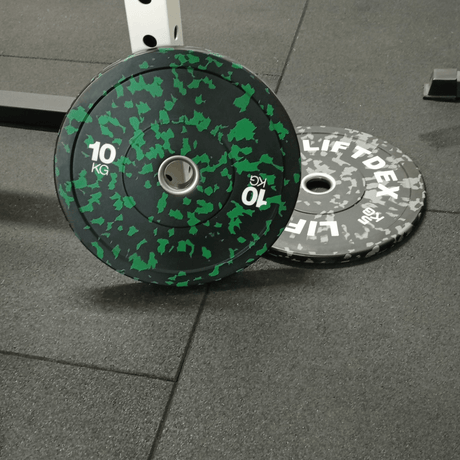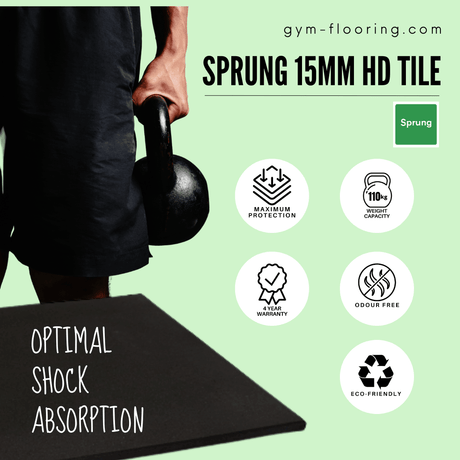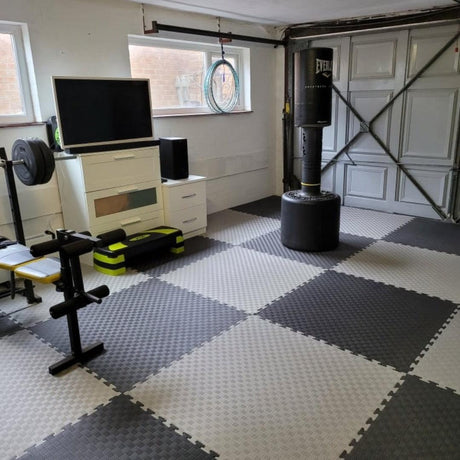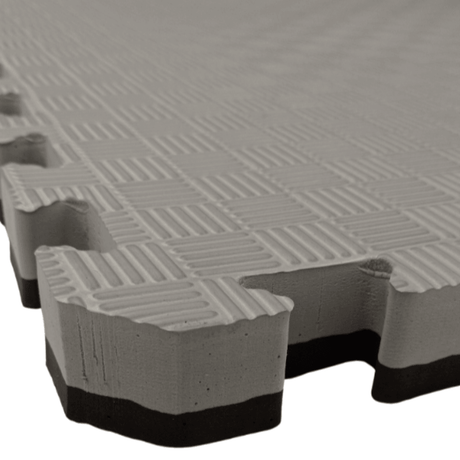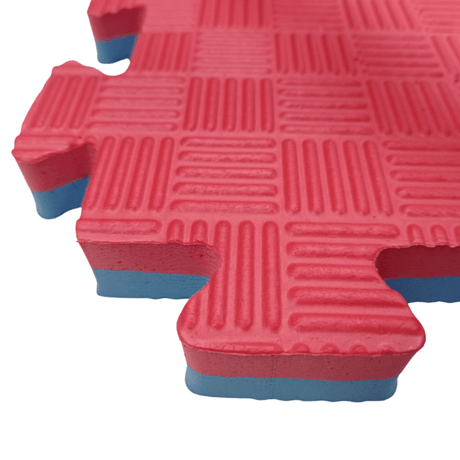When designing an exercise space—whether a home gym, fitness studio or commercial facility—one often overlooked aspect is the flooring. The right flooring not only optimises performance but also prevents injuries.
Different activities require different surfaces and knowing what works for your workout style makes all the difference.
Here’s a breakdown of gym flooring options for specific activities and why they’re essential for safety.
Table of Contents
1. Rubber Tiles with Anti-Shock Properties: A Weightlifting Essential
2. Seamless Slip-Resistant Rubber Rolls: For Busy Cardio and Heavy Equipment Areas
3. Synthetic Turf: A Game-Changer for Sled Pushing and Functional Fitness
4. Yoga Matting: For Mindful Movement
Other Tips for Injury Prevention
1. Rubber Tiles with Anti-Shock Properties: A Weightlifting Essential

When it comes to weightlifting, especially Olympic weightlifting, the flooring needs to be tough, durable and shock-absorbent. Rubber tiles with anti-shock properties are perfect for this. These tiles can handle the impact of heavy barbells being dropped, not only protecting the flooring underneath but also minimising the risk of rebound injuries or damage to equipment.
Without cushioning, repeated impacts can cause joint stress, especially knees, hips and lower back. Unstable surfaces increase the risk of slips which can lead to accidents during lifting.
Benefits:
- Absorbs shock from dropped weights preventing floor damage
- Provides a stable, non-slip surface for lifting.
- Reduces noise, especially for shared areas.
2. Seamless Slip-Resistant Rubber Rolls: For Busy Cardio and Heavy Equipment Areas

If your gym has treadmills, spin bikes or heavy cardio machines, seamless slip-resistant rubber gym flooring rolls are the way to go. These rolls create a smooth surface that prevents trip hazards so users can focus on their workout.
Plus rubber rolls are dense and durable enough to support heavy equipment without compressing over time, which is crucial for a stable base. Their slip-resistant properties are especially important in cardio areas where sweat makes floors slippery.
Benefits:
- Provides consistent grip to reduce slip-and-fall risk.
- Protects subflooring from heavy equipment damage.
- Easy to clean.
Customer Feedback:
"Our order came quickly and well packaged on a pallet. The rolls are of very good quality and we're happy with the colour match to our gym. Looks like top flooring and we're excited to get it fitted."
3. Synthetic Turf: A Game-Changer for Sled Pushing and Functional Fitness

For high intensity functional training like sled pulls or agility exercises, synthetic grass tracks are unbeatable. The texture mimics natural grass, providing grip for sled movements and reducing strain on knees and ankles during dynamic drills.
Hard surfaces or unsuitable flooring for these exercises can cause joint injuries, sprains and shin splints. Synthetic turf sled tracks and high quality sprint tracks absorb impact and provide proper traction for safer transitions and movements.
Benefits:
- Cushioned yet firm surface for agility and sled drills.
- Reduces joint strain during lateral movements and sprints.
- Durable and resistant to wear from dragging sleds or equipment.
4. Yoga Matting: For Mindful Movement

Yoga and pilates require a completely different type of flooring—one that supports balance and mindfulness. Yoga matting provides just the right amount of cushion to protect your wrists, knees and spine during poses.
Hard or too soft floors can cause misalignment or strain, increasing the risk of injuries like wrist pain, lower back issues or even slips in more advanced poses. Yoga matting provides a stable, non-slip base so you can focus on your flow not your footing.
Benefits:
- Cushioned surface protects joints during static and dynamic poses.
- Non-slip design prevents movement-related injuries.
- Lightweight and easy to replace or clean.
Other Tips for Injury Prevention
Flooring alone won’t prevent injuries, so here are a few extra tips to keep in mind for a safer workout space:
-
Proper Footwear: Use activity-specific shoes to provide support and traction.
-
Good Lighting: Ensure your workout area is well-lit to avoid trips and missteps.
-
Maintenance: Regularly clean and inspect your flooring for wear and tear.
-
Warm-Up and Cool-Down: Don’t ignore these essential steps for preparing and recovering your muscles and joints.
-
Floor Compatibility: Choose commercial gym flooring that suits your space—consider moisture levels, subflooring type and room usage.
In summary:

The Bottom Line
Investing in the right gym flooring for your workout space is one of the best decisions you can make for your health and performance. Whether you’re dropping barbells, sprinting on synthetic grass or practicing downward dog, the right surface can enhance your workout and most importantly prevent injuries.
Consider your activities, space and budget when choosing flooring and you’ll create a safer and more effective environment for your fitness journey.
Browse our wide range of fitness flooring for your perfect match.





